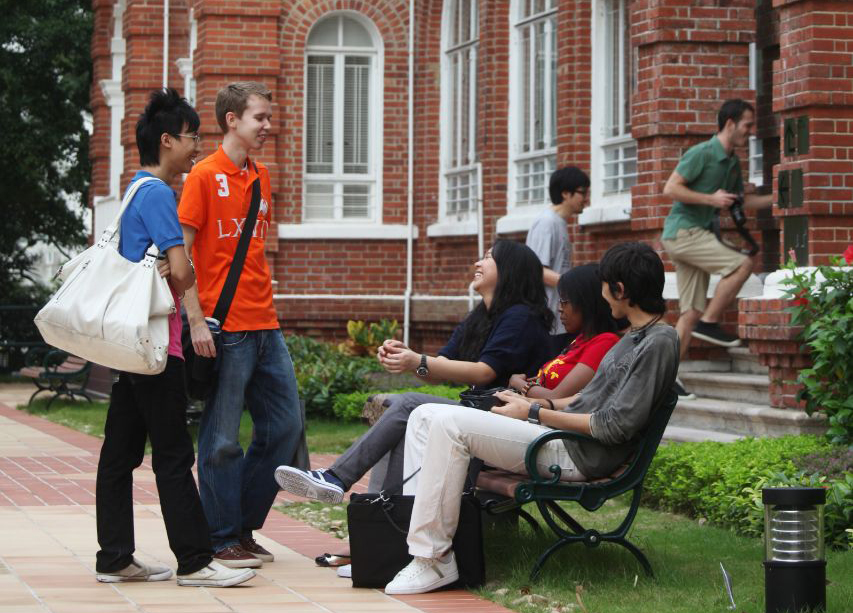Teaching and Learning Resources
Engaging local and non-local students – Good practices and tips
HKU’s vision statement for 2016-2025 specifies Internationalisation as one of the 3+1 I’s supporting the University’s commitment to being Asia’s Global University, alongside Interdisciplinarity, Innovation and Impact. The University is aiming to provide all students with an international learning experience through ‘further developing our curricula and our vibrant, cosmopolitan campus, nurturing globally-minded thinkers and leaders, and providing space and opportunity for students to gain exceptional learning experiences outside Hong Kong’.1
One of the important aspects of internationalisation is to enable students, regardless of their nationality or cultural background, to benefit from a more diverse learning environment. This might be easier said than done since there are many intertwined factors affecting the learning and interactions among students from various backgrounds. Here are a number of good practices and tips based on the literature and a small-scale pilot study at HKU.

Good practices
- Accommodating and Respecting Diversity
- Making an effort to understand all students’ cultural and educational backgrounds and prior learning experiences
- Inviting students to share their life and work experiences as inputs for classroom discussions and possible learning resources
- Helping students see and appreciate multiple perspectives
- Encouraging students to challenge established worldviews and explore alternatives
Tools: Provide readings that show very different and somehow contradictory views
- Providing Clear Instructions and Specific Support
- Highlighting important points and making them readily accessible (e.g., through Moodle)
- Offering specific support to students according to their different needs and experiences
- Clarifying expectations, intended learning outcomes, and criteria of assessment
- Providing exemplars and encouraging students to raise questions about the exemplars
- Facilitating Meaningful Intercultural Interaction
- Designing meaningful intercultural group tasks to which students from different cultural backgrounds can contribute their unique perspectives
Example (from a project led by University of Melbourne2): One teacher who teaches first-year science course starts each class session with a question that students discuss in pairs or groups. They stay with their partners during the same class session while they are encouraged to work with someone different each week.
- Communicating clearly to students the purpose of the intercultural group tasks and providing guidance in effective groupwork processes
Example (from a project led by University of Melbourne3): One teacher who teaches a postgraduate course in consultancy requires students to undertake research projects in teams. Each team has students from different backgrounds. As a team, students identify companies and work with them to define and address a research problem. International students are encouraged to provide their inputs based on their knowledge of and experiences in their home countries.
- Paying attention to students’ level of involvement in intercultural groupwork and providing feedback during the processes
- Assessing both groupwork processes and outcomes
HKU Example: Group-based game outside of classroom was implemented in one Common Core course related to history at HKU. The game was based on scavenger hunt, facilitated by an interactive, automated online programme. The excitement and challenge of the game taking place outside the classroom effectively broke down boundaries between students from different cultural backgrounds.Tips: Mixing international and local students in group activities requires a clear purpose, which also needs to be well communicated to all students4. For example, there could be a linkage between the group tasks and the cultural related learning outcomes. - Designing meaningful intercultural group tasks to which students from different cultural backgrounds can contribute their unique perspectives
- Developing Global Citizenship
- Developing students’ understanding of the requirements of professional practice and citizenship
- Presenting students with global challenges and engaging them to discuss how these challenges are interrelated and will impact on their professional and personal lives
- Providing students with opportunities to interact with the local community and encouraging them to care about, and contribute to the community
- Developing students a sense of personal responsibilities to the public
Example from the literature: A comparative cultural study requiring international and local students to work collaboratively was implemented in a compulsory culture course for international students in Hong Kong Institute of Education (now the Education University of Hong Kong). Students were grouped in pairs or small groups with mixed cultural backgrounds to examine a local cultural issue. The group tasks involved studying local artefacts and conducting field-based research5. - Promoting Critical Thinking and Deep Inquiry
- Acknowledging different interpretations and traditions of critical thinking and deep inquiry
- Explaining the meaning of critical thinking and inquiry skills required in the discipline with examples
- Encouraging students to explore alternatives and challenge existing solutions Designing diversified assessment methods and providing feedback during different stages
HKU Example: Scaffolding critical thinking skills for students with a tendency to conform to the authority. In one Common Core course at HKU, the teacher tried to help students overcome the tendency to conform to authority by giving examples of how established viewpoints might be challenged. The teacher showed the process of analysing existing solutions to a science problem and encouraged students to further think about why some science problems still remained unsolved.
More Resources on Internationalisation of the Curriculum and Teaching across Cultures
Internationalisation of the Curriculum in the Common Core
- Briefing: http://www.cetl.hku.hk/teaching-learning-cop/wp-content/uploads/2016/06/international_01.pdf
- HKU examples: http://www.cetl.hku.hk/teaching-learning-cop/wp-content/uploads/2016/06/international_01_insert_hku.pdf
- Examples elsewhere: http://www.cetl.hku.hk/teaching-learning-cop/wp-content/uploads/2016/06/international_01_insert_elsewhere.pdf
Teaching across Cultures: Issues, Strategies and Actions
- Briefing: http://www.cetl.hku.hk/teaching-learning-cop/wp-content/uploads/2016/06/international_06.pdf
- HKU examples: http://www.cetl.hku.hk/teaching-learning-cop/wp-content/uploads/2016/06/international_06_insert_hku.pdf
- Examples elsewhere: http://www.cetl.hku.hk/teaching-learning-cop/wp-content/uploads/2016/06/international_06_insert_elsewhere.pdf
Teaching and Learning Connections (e-newsletter, Issue No. 3)
Internationalisation of Teaching and Learning
http://www.cetl.hku.hk/teaching-learning-cop/issue-03/
(Including articles from different faculties at HKU on internationalisation of the curriculum and internationalisation at home)
Teaching and Learning Connections (e-newsletter, Issue No. 4)
Internationalisation of Teaching and Learning: Cultural Aspects
http://www.cetl.hku.hk/teaching-learning-cop/issue-04/
(Including articles from different faculties at HKU on teaching across cultures and engaging students from different backgrounds)
1 HKU (2015). Asia’s Global University: The Next Decade Our Vision for 2016-2025. Available at: http://www.sppoweb.hku.hk/vision2016-2025.pdf
2 Arkoudis, S., Yu, X. Baik, C., Borland, H., Chang, S., Lang, I., Lang, J., Pearce, A., & Watty, K. (2010). Finding Common Ground: enhancing interaction between domestic and international students. http://www.olt.gov.au/project-enhancing-domestic-international-melbourne-2008, p. 16
3 See Note 2, p. 16.
4 Leask, B. (2015). Internationalisation of the Curriculum. Abingdon: Routledge. p.80.
5 Bodycott, P., Mak, A. S., & Ramburuth, P. (2014). Utilising an internationalised curriculum to enhance students’ intercultural interaction, engagement and adaptation. Asia-Pacific Education Researcher, 23(3), 635–643.



